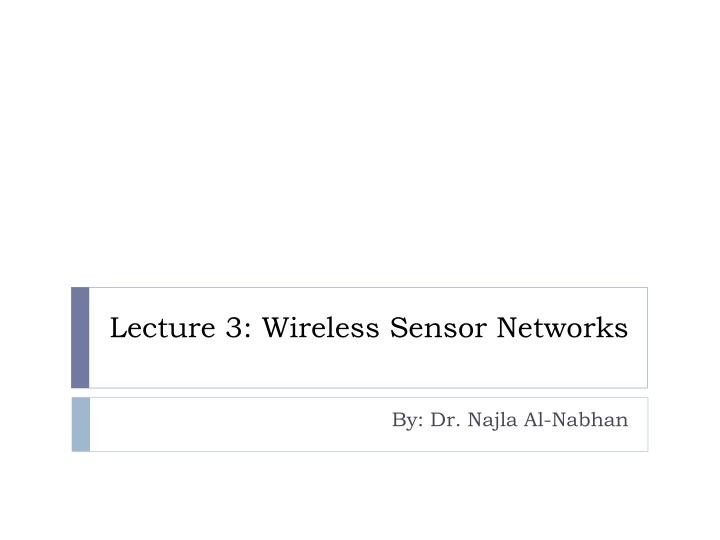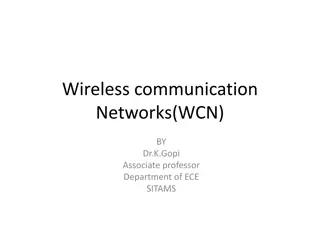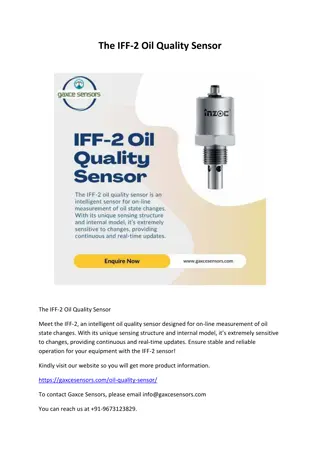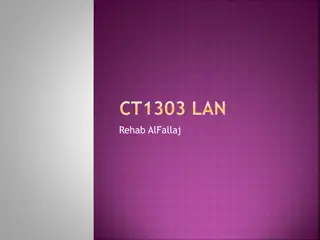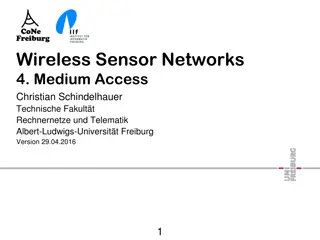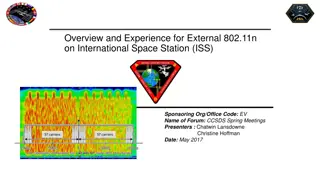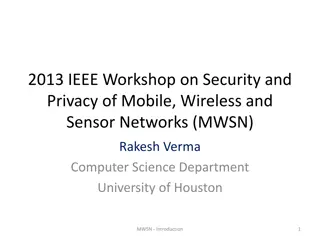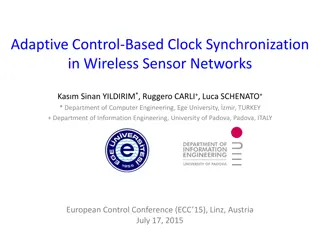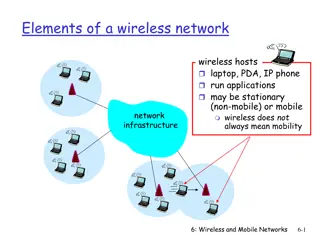Wireless Sensor Networks: Overview and Applications
Wireless Sensor Networks are networks of distributed sensors that collaborate to sense physical phenomena and process gathered information. This article covers the architecture, components, applications, and comparisons of WSNs with ad hoc networks.
Download Presentation

Please find below an Image/Link to download the presentation.
The content on the website is provided AS IS for your information and personal use only. It may not be sold, licensed, or shared on other websites without obtaining consent from the author.If you encounter any issues during the download, it is possible that the publisher has removed the file from their server.
You are allowed to download the files provided on this website for personal or commercial use, subject to the condition that they are used lawfully. All files are the property of their respective owners.
The content on the website is provided AS IS for your information and personal use only. It may not be sold, licensed, or shared on other websites without obtaining consent from the author.
E N D
Presentation Transcript
Lecture 3: Wireless Sensor Networks By: Dr. Najla Al-Nabhan
Wireless Sensor Networks (WSNs) A sensor network is a wireless network that consists of thousands of very small nodes called sensors. Base station Figure 1: Architecture of wireless sensor networks 2
Wireless Sensor Networks (cont.) WSN Sensors are equipped with sensing, limited computation, and wireless communication capabilities. Figure 2: Typical hardware components of a sensor node in wireless sensor networks 3
Introduction Wireless Sensor Networks are networks that consists of sensors which are distributed in an ad hoc manner. These sensors work with each other to sense some physical phenomenon and then the information gathered is processed to get relevant results. Wireless sensor networks consists of protocols and algorithms with self-organizing capabilities. 4 Introduction to Wireless Sensor Networks
Comparison with ad hoc networks Wireless sensor networks mainly use broadcast communication while ad hoc networks use point-to-point communication. Unlike ad hoc networks wireless sensor networks are limited by sensors limited power, energy and computational capability. Sensor nodes may not have global ID because of the large amount of overhead and large number of sensors. 5 Introduction to Wireless Sensor Networks
WSNs Applications WSNs have many advantages over traditional networking techniques. They have an ever-increasing number of applications, such as infrastructure protection and security, surveillance, health-care, environment monitoring, food safety, intelligent transportation, and smart energy. 6
WSNs Applications 7 Figure 3: WSNs Applications
Applications of Wireless Sensor networks The applications can be divided in three categories: Monitoring of objects. Monitoring of an area. Monitoring of both area and objects. 1. 2. 3. 8 Introduction to Wireless Sensor Networks
Monitoring Area Environmental and Habitat Monitoring Precision Agriculture Indoor Climate Control Military Surveillance Intelligent Alarms 9 Introduction to Wireless Sensor Networks
Example: Precision Agriculture Precision agriculture aims at making cultural operations more efficient, while reducing environmental impact. The information collected from sensors is used to evaluate optimum sowing density, estimate fertilizers and other inputs needs, and to more accurately predict crop yields. 10 Introduction to Wireless Sensor Networks
Monitoring Objects Structural Monitoring Eco-physiology Condition-based Maintenance Medical Diagnostics Urban terrain mapping 11 Introduction to Wireless Sensor Networks
Monitoring Interactions between Objects and Space Wildlife Habitats Disaster Management Emergency Response Ubiquitous Computing Asset Tracking Health Care 12 Introduction to Wireless Sensor Networks
Characteristics of Wireless Sensor Networks Wireless Sensor Networks mainly consists of sensors. Sensors are - low power limited memory energy constrained due to their small size. Wireless networks can also be deployed in extreme environmental conditions and may be prone to enemy attacks. Although deployed in an ad hoc manner they need to be self organized and self healing and can face constant reconfiguration. 13 Introduction to Wireless Sensor Networks
Design Challenges Heterogeneity The devices deployed maybe of various types and need to collaborate with each other. Distributed Processing The algorithms need to be centralized as the processing is carried out on different nodes. Low Bandwidth Communication The data should be transferred efficiently between sensors 14 Introduction to Wireless Sensor Networks
Continued.. Large Scale Coordination The sensors need to coordinate with each other to produce required results. Utilization of Sensors The sensors should be utilized in a ways that produce the maximum performance and use less energy. Real Time Computation The computation should be done quickly as new data is always being generated. 15 Introduction to Wireless Sensor Networks
Operational Challenges of Wireless Sensor Networks Energy Efficiency Limited storage and computation Low bandwidth and high error rates Errors are common Wireless communication Noisy measurements Node failure are expected Scalability to a large number of sensor nodes Survivability in harsh environments 16 Introduction to Wireless Sensor Networks
Enabling Technologies Embed numerous distributed devices to monitor and interact with physical world Network devices to coordinate and perform higher-level tasks Embedded Networked Control system w/ Small form factor Untethered nodes Exploit collaborative Sensing, action Sensing Tightly coupled to physical world Exploit spatially and temporally dense, in situ, sensing and actuation 17 Introduction to Wireless Sensor Networks
Future of WSN Smart Home / Smart Office Sensors controlling electrical devices in the house. Better lighting and heating in office buildings. The Pentagon building has used sensors extensively. 18 Introduction to Wireless Sensor Networks
Biomedical / Medical Health Monitors Glucose Heart rate Cancer detection Chronic Diseases Artificial retina Cochlear implants Hospital Sensors Monitor vital signs Record anomalies 19 Introduction to Wireless Sensor Networks
Military Remote deployment of sensors for tactical monitoring of enemy troop movements. 20 Introduction to Wireless Sensor Networks
Industrial & Commercial Numerous industrial and commercial applications: Agricultural Crop Conditions Inventory Tracking In-Process Parts Tracking Automated Problem Reporting Theft Deterrent and Customer Tracing Plant Equipment Maintenance Monitoring 21 Introduction to Wireless Sensor Networks
Traffic Management & Monitoring Future cars could use wireless sensors to: Handle Accidents Handle Thefts Sensors embedded in the roads to: Monitor traffic flows Provide real-time route updates 22 Introduction to Wireless Sensor Networks
References Source www.cse.fau.edu/~jie/teaching/fall_2004_files/sensorslides1.ppt http://web2.uwindsor.ca/courses/cs/aggarwal/cs60520/SeminarMaterial/WSN-future.ppt http://web.cecs.pdx.edu/~nbulusu/talks/grace-hopper.ppt http://galaxy.cs.lamar.edu/~bsun/wsn/wsn.html www.dsc.ufcg.edu.br/~maspohn/katia/introduction.ppt http://computer.howstuffworks.com/mote1.htm http://www.polastre.com/papers/polastre-thesis-final.pdf 23 Introduction to Wireless Sensor Networks
